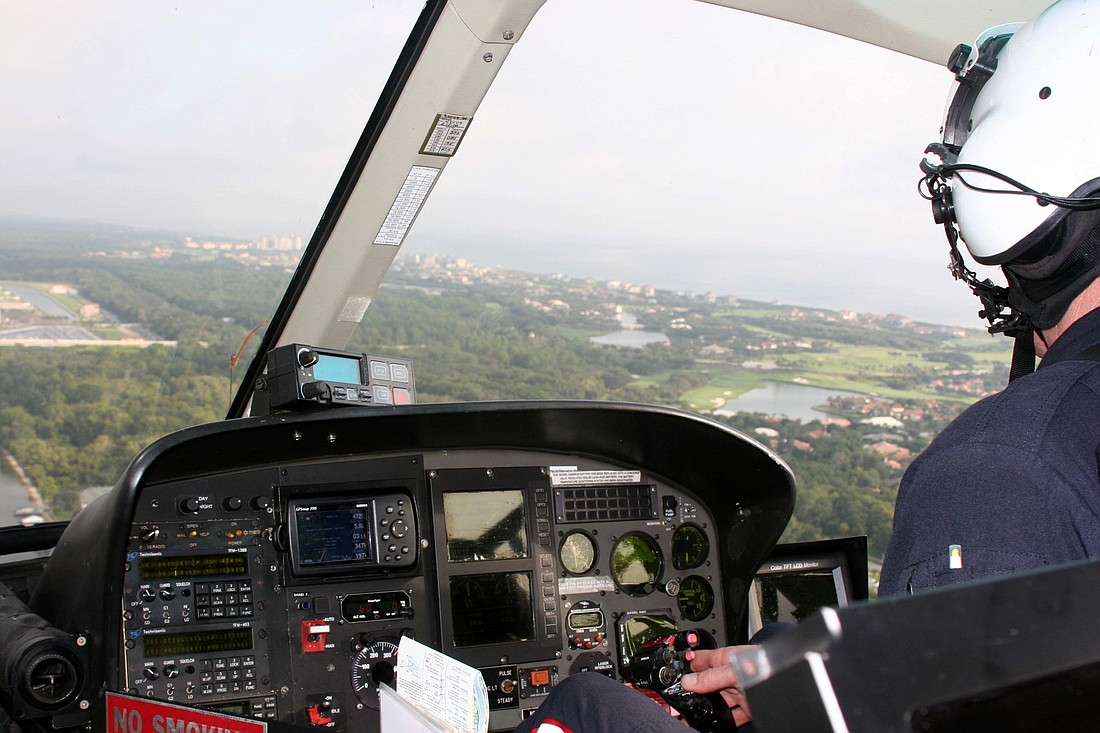- March 14, 2025

Hearing the thrumming chop overhead of the FireFlight helicopter is a sign that Flagler County is doing all it can to keep residents safe – whether it’s a reconnaissance mission to look for wildfires, to look for a missing person, to help the Sheriff catch a criminal, or to transport a patient for medical care.
But while in flight, who watches out for the safety of the county’s helicopter, pilots, flight medics, and patients? The answer is those who work in either Dispatch or Emergency Management, all of whom are trained in “flight following.” It is a system that requires the use of a specialized website application, once-every-10-minute operational checks, and accountability documentation that is updated in live time so that every move the helicopter makes is captured.
“Flight following is required by the FAA (Federal Aviation Administration) whenever you transport a patient, but we use it every time we take the helicopter up,” said Flight Operations Chief Dana Morris. “We also go above and beyond the FAA regulations for the safety of our operations.”
The FAA set a stringent policy for transporting patients – essentially a commercial endeavor as fees are charged for air ambulance services – after a number of tragic accidents like the 2004 crash into the Choctawhatchee Bay killing three people including the pilot, a nurse, and a paramedic, who set out to transfer a critically ill patient from one hospital in Defuniak Springs to one in Pensacola.
“You never forget stories like this,” said Morris, noting that the relatively small pool of helicopter pilots makes them a particularly close-knit community. “This was especially sad, because they radioed they were going to return shortly after they left because of bad weather. They crashed and somehow no one realized they were missing until the shift change the next day.”
Though transporting patients is only part of what FireFlight does per its FAA Part 135 Certification, following top-level safety protocols is a must as far as Morris is concerned.
“While helicopters are very expensive, that cost pales in comparison to the cost of human life,” Morris said. “There are some risks that just aren’t worth taking.”
Pilots Morris and Todd Whaley are evaluated annually by the FAA to ensure standards are met to provide air ambulance transport services to the community. They are required to take a three-hour oral exam to test their knowledge of FAA regulations, operations specifications, and general operations manual specific to Flagler County, as well as FireFlight helicopter specific questions about its systems, performance, and emergency procedures.
Daily, they go through a checklist at the beginning of the day to ensure the aircraft is flight-worthy – something they will have to confirm they have done with Dispatch before taking off. Morris and Whaley also complete a Flight Risk Analysis Tool before putting FireFlight in the air that gives them a number between zero and 30, 11 being the highest numeric risk in which a helicopter is permitted to fly.
“That might be what is allowable, but we don’t fly if our FRAT number is 11 – or anywhere close,” Morris said. “We’ll turn it down.”
Flight followers have their own FAA checklist, an electronic “Flight Planning Form” to safeguard procedures (paper versions are available in the event of a power outage).
“Our dispatch center documents who the pilot is, how much fuel the helicopter has, destination, FRAT number, and how many souls are on board,” said Flagler County Sheriff’s Office Director of Communications Christina Mortimer. “In the event of an emergency, our dispatchers are trained to make proper notifications and provide the information required by the FAA.”
Morris relies on Emergency Management Specialist Bob Pickering to drill down for specifics when the weather looks “iffy,” as well as assist him with teaching the Flight Following Training Course.
“Everything we do follows more stringent procedures than what is called for,” Pickering said. “Our landing zones are tighter. Everything is safety first. We couldn’t do this without the help of the Call Center (Dispatch).”
The Flight Following Training Course is required for all dispatchers.
“Upon completion, they receive certification in Flight Operations FAA Part 135 County Dispatcher, which certifies them to track Fire Flight when they fly on missions,” Mortimer said. “This training provides the dispatchers with the required information that needs to be obtained prior to FireFlight taking flight.”
Flagler County purchased FireFlight in 2002. It has air ambulance records going back to its first medical flight August 19 of that same year. Electronic flight planning forms for every mission go back to June 22, 2012. Flight following operations shifted in 2015 from Emergency Management staff – who now serve as backup – to Dispatch.